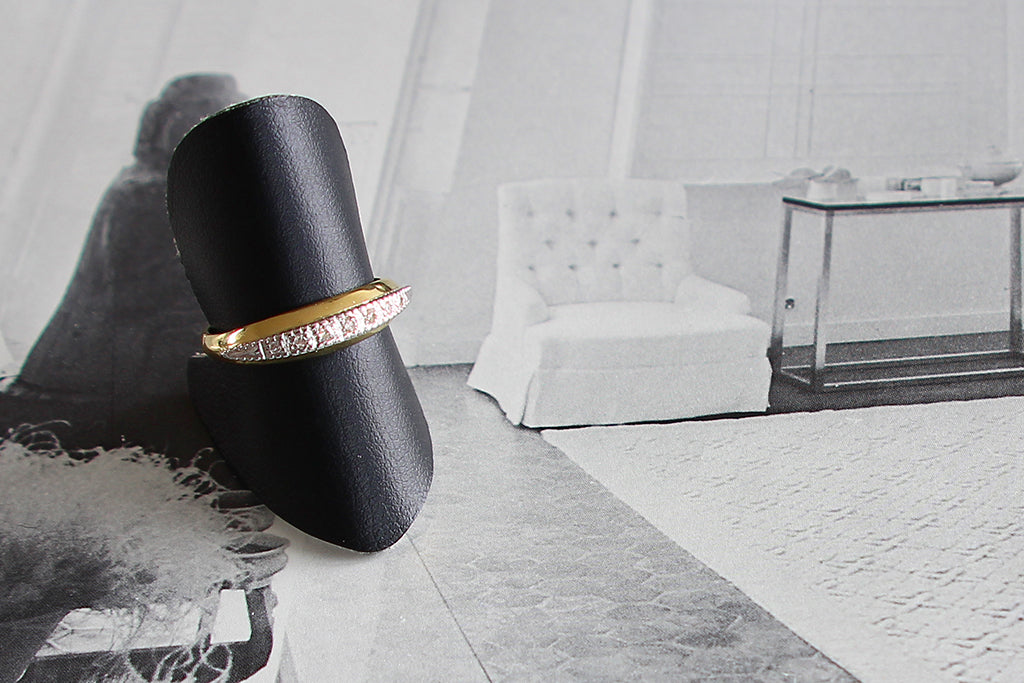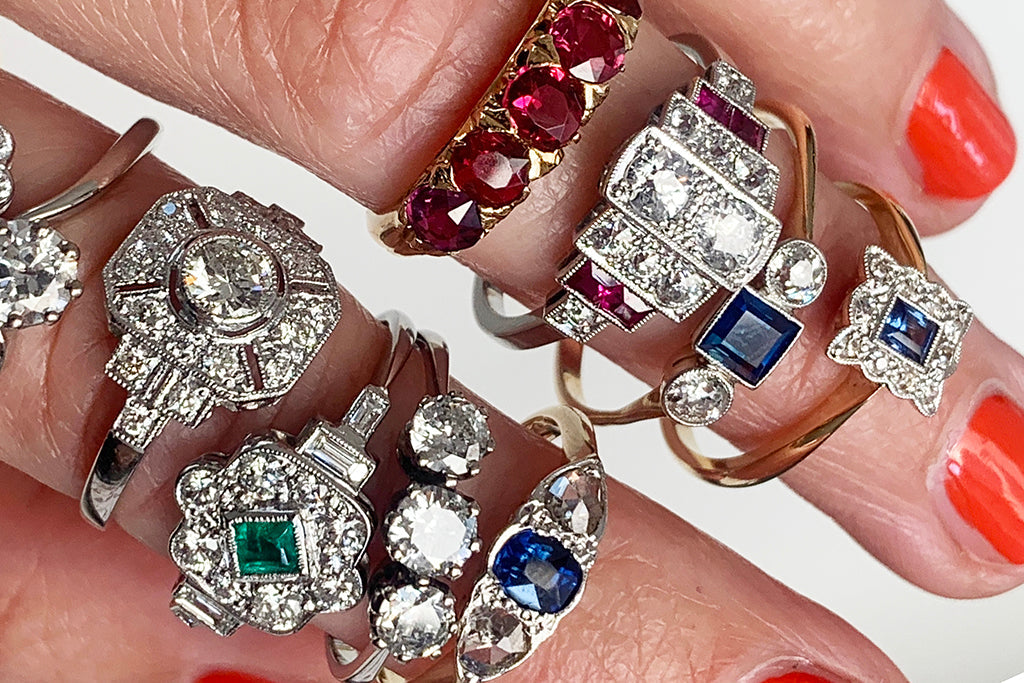
Between rock and a hard place: 1970s jewellery design and the world that shaped it
The 1970s was a decade defined by turmoil and revolution, punctuated with historical events that shaped politics, economics and cultural attitudes irreversibly. Today, we’re exploring some of the most distinctive features of jewellery from this transformative era and how they held a mirror to the world around them.
FUTURISM AND GEOMETRY

From the continuation of various lunar missions to the launch of the first space station, the exploration of planets such as Jupiter, Saturn and Mars, and the beginning of cooperation between the USA and the Soviet Union after a 20-year space race, the ‘70s played host to ground-breaking progressions in space exploration.
In turn, sci-fi films and TV programmes skyrocketed in popularity, with the first ever Star Wars film released in 1977 – the same year as Steven Spielberg’s cult classic, Close Encounters of the Third Kind – and Star Trek gaining a lasting dedicated fan-base.
Reflecting humanity’s understandable fascination with technological advancement and faraway worlds, 1970s jewellery design was heavily influenced by futuristic and mechanical themes. This included space-related motifs like stars and planets and linear, geometric shapes. Arguably, the familiarity of these straight lines might also allude to a desire for order and structure in a rapidly evolving world.
With her split shank, baguette-cut diamonds and asymmetric half-halo, Tabitha is a prime example of the graphic and inventive style so typical of the time. Starbursts can also be found hand-engraved into the shoulders of Angela, another vintage ring hailing from ‘70s.
DISCO AND GLAMOUR

The ‘70s was also a landscape of injustice, division and unrest. When an oil embargo was imposed by the Organisation of Petroleum Exporting Countries (OPEC) in 1973, the global economy was impacted by widespread oil shortages, and rising energy prices. 1974 opened the curtain on The Watergate Scandal, which revealed a dark web of political corruption and abuses of power, leading to the resignation of President Richard Nixon and a lasting legacy of public distrust in the government. In the early half of the decade, the brutal and highly divisive Vietnam War continued to wreak devastation in Vietnam. Between 1975 and 1979, the Khmer Rouge army – led by totalitarian dictator Pol Pot – orchestrated a savage genocide in Cambodia, resulting in the deaths of an estimated two million people.
It’s no surprise, then, that the decade was also an era marked by hedonism. As people sought escape from social and political tensions of the time, disco culture offered a refuge in the form of music, dance, community and glamour.
Emerging in urban areas, especially New York City, disco music evolved from a blend of musical genres, including funk, soul, R&B and Latin. This multicultural appeal lured people from myriad racial and social backgrounds, with disco clubs known as melting pots that were more inclusive than other entertainment venues at the time. This reputation also encouraged many LGBTQ+ individuals to find solace and a sense of belonging. In a world that felt like a frightening and merciless place, disco clubs became safe spaces.
With a sense of security often comes greater freedom of self-expression, so disco culture quickly became synonymous with bold and exciting fashion statements. The movement’s influence on jewellery design specifically was marked by its celebration of opulence and flamboyance, driving surges in rhinestone-like clusters of shimmering diamonds, gemstones in loud colours, and general showiness. Amy is the epitome of '70s jewellery design, screaming playful glitz and glamour.
BOLD AND CHUNKY DESIGNS

In the ‘70s alone, the Women’s Liberation Movement drove the legalisation of abortion in the US, the banning of same-sex discrimination in American educational institutions, political activism in the form of protests, lobbying and women running for political office, ground-breaking advocacy for women’s rights to work, equal pay and higher education, seminal feminist literature like Simone de Beauvoir’s The Second Sex and Betty Friedan’s The Feminine Mystique, and the work of activists like Marsha P. Johnson and Sylvia Rivera, who strove for the rights of transgender and gender-nonconforming individuals.
The decade was an era of revolution and confidence, with some women feeling a novel sense of freedom to express their identity and beliefs. This is particularly true of those who benefitted directly from those advances towards gender equality, suddenly enjoying newfound economic prosperity thanks to greater employment opportunities. This psyche was reflected by the bold and oversized forms that dominated fashion catwalks. In terms of jewellery design, this translated as wide bands, chunky chains and big, proud gemstones.
Broad and raised grandly from the finger, Angie is the epitome of a ‘70s jewel refusing to be shushed.
FLASH GOLD AND PRECIOUS GEMSTONES

Whilst the prominence of organic and natural materials like wood, leather and feathers reflected the hippies’ passion for environmentalism and spiritual exploration, high-carat gold and precious gemstones remained popular choices for jewellery throughout the ‘70s.
As explored already in this blog post, the decade was largely an era of crisis and volatility, producing a number of complex global economic challenges. From an aerial view, however, it was ultimately a period of fluctuations; its troughs followed by peaks. When the global oil crisis of 1973 drove prices of oil through the roof, for example, the economies of the countries producing it benefitted from a significant boost. Increased globalisation, including the development of the European Economic Community (which later became the EU) gave rise to international trade and economic expansion. Low unemployment and wage increases in the decade's early years lead to housing booms and higher consumer spending. Advances in technology, like the evolution of the computer industry, created a wealth of new job opportunities.
For the lucky ones, the ‘70s was a period of marked economic prosperity. This gave the luxury fashion industry an historic boost, with high-end brands and fashion houses gaining newfound popularity worldwide. Celebrities began to appear in more advertising and marketing than ever before, promoting coveted products. TV and film like Charlie’s Angels and Saturday Night Fever embraced extravagant lifestyles and glamorous fashion choices.
This fascination with celebrity and opulence was clearly reflected in the polished and highly gemstone encrusted jewellery designs so popular at the time. Angela, our 1970s cluster engagement ring, draws attention to her 18ct yellow and white gold shoulders with shimmering starburst details, her five diamonds stacked atop one another to create a light-refractive cluster.
Though diverse and eclectic, the mannerisms of 1970s jewellery design are united by their roots in change; expressing desires for self-expression, individualism and futurism, they capture a period of irreversible evolution.


